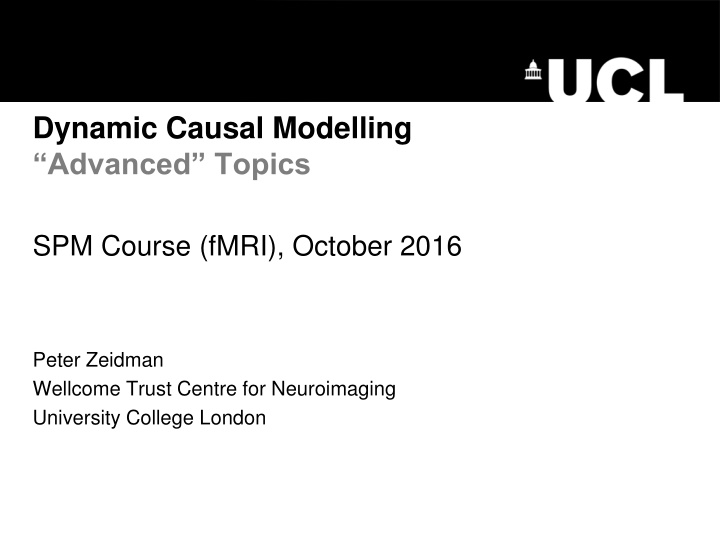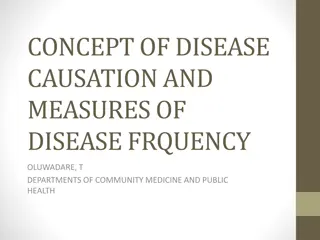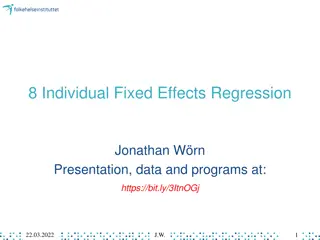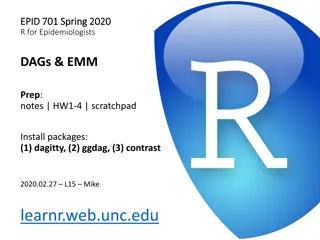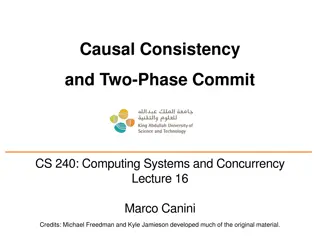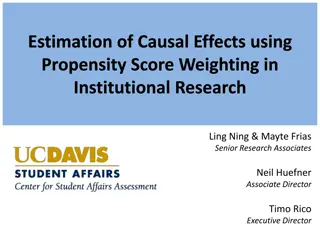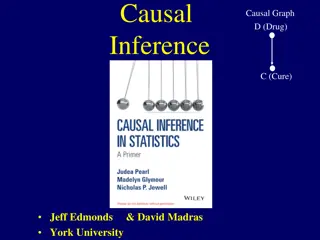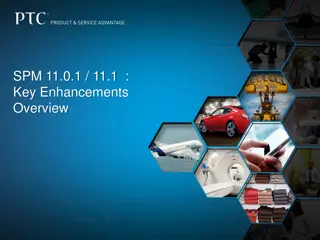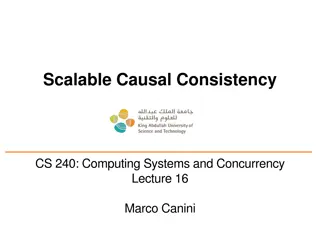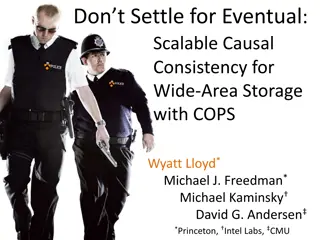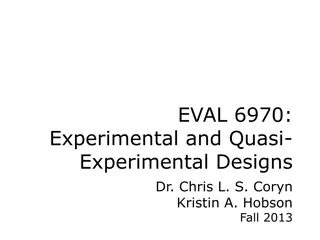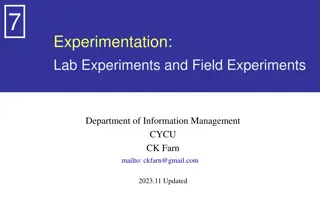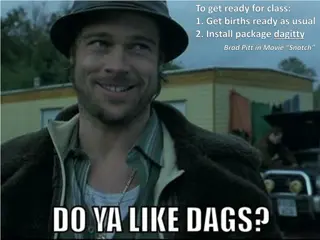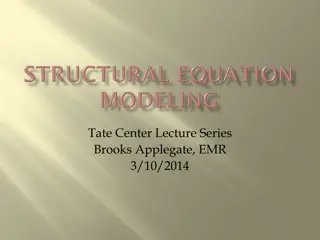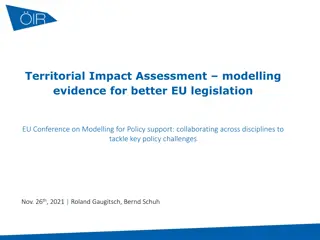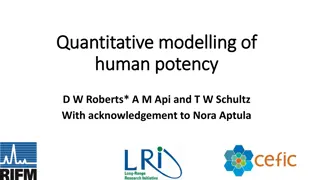Dynamic Causal Modelling
"Peter Zeidman presents Dynamic Causal Modelling Advanced Topics at the Wellcome Trust Centre for Neuroimaging, University College London in October 2016. This course focuses on in-depth understanding and practical applications of dynamic causal modelling in functional magnetic resonance imaging (fMRI) analysis. Participants will explore advanced techniques and methodologies in the field of neuroimaging, with a specific focus on modelling the causal interactions between brain regions."
Download Presentation

Please find below an Image/Link to download the presentation.
The content on the website is provided AS IS for your information and personal use only. It may not be sold, licensed, or shared on other websites without obtaining consent from the author.If you encounter any issues during the download, it is possible that the publisher has removed the file from their server.
You are allowed to download the files provided on this website for personal or commercial use, subject to the condition that they are used lawfully. All files are the property of their respective owners.
The content on the website is provided AS IS for your information and personal use only. It may not be sold, licensed, or shared on other websites without obtaining consent from the author.
E N D
Presentation Transcript
Dynamic Causal Modelling Advanced Topics SPM Course (fMRI), October 2016 Peter Zeidman Wellcome Trust Centre for Neuroimaging University College London
Preprocessing Statistical inference (voxels / clusters) Connectivity analysis Image time-series Statistical Parametric Map Design matrix Model Realignment General Linear Model Smoothing Dynamic Causal Modelling Statistical Inference Normalisation Random Field Theory Anatomical reference Functional timeseries p < 0.05
The system of interest Experimental Stimulus (Hidden) Neural Activity Observations (BOLD) Vector u Vector y on BOLD ? off time time Stimulus from Buchel and Friston, 1997 Brain by Dierk Schaefer, Flickr, CC 2.0
DCM Framework Observation Model Neural Model Experimental Stimulus (u) Observations (y) How brain activity z changes over time What we would see in the scanner, y, given the neural model? . z = f(z,u, n) y = g(z, h) Stimulus from Buchel and Friston, 1997 Figure 3 from Friston et al., Neuroimage, 2003 Brain by Dierk Schaefer, Flickr, CC 2.0
DCM Recipe 1. Identify regions of interest 2. Design your model space Planning 3. Extract timeseries 4. Specify a DCM for each subject 5. Estimate (fit) model 1st level 6. Build a second level model (PEB) 7. Test hypotheses 2nd level
DCM Recipe 1. Identify regions of interest 2. Design your model space Planning 3. Extract timeseries 4. Specify a DCM for each subject 5. Estimate (fit) model 1st level 6. Build a second level model (PEB) 7. Test hypotheses 2nd level
1. Identify Regions of Interest We could also do an initial simple connectivity analysis (e.g. PPI for task-based studies, ICA for resting state) We generally start with SPM results Psychophysiological interactions (PPI) Where in the brain has increased correlation with early visual cortex (V1) when paying attention relative to relaxing? Voxel y neuronal activity 12 Attention 10 8 6 No Attention 4 2 0 V1 neuronal activity
2. Design your model space Main effect of face: FFA A (fictitious!) example of a 2x2 design: Factor 1: Stimulus (face or inverted face) Factor 2: Valence (neutral or angry) Interaction of Stimulus x Valence: Amygdala Valence From a factorial design: Main effect 1 driving inputs Main effect 2 modulatory input thus testing for an interaction Face FFA Amy
2. Design your model space Valence Face Full model FFA Amy Valence Face FFA Amygdala model FFA Amy Valence Face Amygdala FFA model FFA Amy
DCM Recipe 1. Identify regions of interest 2. Design your model space Planning 3. Extract timeseries 4. Specify a DCM for each subject 5. Estimate (fit) model 1st level 6. Build a second level model (PEB) 7. Test hypotheses 2nd level
3. Extract timeseries An anatomical mask A sphere with given radius Positioned at the group peak of an SPM, PPI or ICA analysis or Allowed to vary for each subject, within a radius of the group peak +
3. Extract timeseries A. Regress out nuisance effects (anything not specified in the effects of interest f-contrast ) B. Remove confounds such as low frequency drift C. Summarise the ROI by performing PCA and retaining the first component 1st eigenvariate: test 3 New in SPM12: VOI_xx_eigen.nii (When using the batch only) 2 1 0 -1 -2 -3 -4 200 400 600 800 1000 time \{seconds\} 230 voxels in VOI from mask VOI_test_mask.nii Variance: 81.66%
4. Specify DCM Bilinear or nonlinear? Bilinear Non-linear R2 R2 z2 z2 R3 R3 R1 R1 z1 z1 Modulatory Nonlinear Stephan et al. 2008, NeuroImage
4. Specify DCM States per region? Microcircuit 1-state DCM 2-state DCM Superficial Pyramidal R2 z2 Spiny stellate Inhibitory interneurons Deep pyramidal R1 z1 Friston et al., in preparation
4. Specify DCM Stochastic effects? In stochastic DCM, random fluctuations can drive the network: ???? ? + ?? + ?? ? = ? + ? v = u + ?? Li et al., NeuroImage, 2011
4. Specify DCM Timeseries or CSD? DCM for Cross-Spectral Densities Operates in the frequency domain rather than the time domain. Ideal for resting state analysis Friston et al. 2014, NeuroImage
4. Specify DCM Which connections? On / off switches set the priors Valence Face FFA Amy Connection off Connection on Probability 0 0 Connect strength (Hz) Connect strength (Hz)
5. Estimate each subjects model (Experimental inputs) time Our belief about each parameter is represented by a normal distribution with a mean and variance (uncertainty) We represent and estimate the full covariance matrix between parameters: Predicted data (e.g. timeseries) Image credit: Marcin Wichary, Flickr
5. Estimate each subjects model (diagnostics) spm_dcm_fmri_check(DCM) spm_dcm_explore (DCM) From Jean Daunizeau s website responses and predictions variance explained 87% 4 3 2 1 0 -1 -2 0 200 400 600 800 1000 1200 time {seconds} posterior correlations estimable parameters 13 intrinsic and extrinsic connections largest connection strength 0.58 1 10 0.5 20 0 30 -0.5 40 50 -1 1 2 3 4 5 6 7 8 9 10 20 30 40 50 parameter}
DCM Recipe 1. Identify regions of interest 2. Design your model space Planning 3. Extract timeseries 4. Specify a DCM for each subject 5. Estimate (fit) model 1st level 6. Build a second level model (PEB) 7. Test hypotheses 2nd level
Group analyses Options: Model of models Question: I think that different subjects had their data generated by different DCMs. Which of several DCMs best explains my data? Conclusion: There is a 96% probability that any randomly chosen subject had their data generated by DCM 1 rather than DCM 2 Random effects Bayesian Model Selection (Stephan et al. 2009) Model of parameters Question: Do patients have stronger connectivity between two regions in my DCM compared to matched controls? Conclusion: Patients have 20% stronger self-inhibition within PFC Parametric Empirical Bayes (Friston et al. 2016)
6. Build a second level model (Parametric Empirical Bayes) PEB GLM Second level ? = ?? + ?2 ?2 ~ ?(0, ) DCM: Subject 1 DCM: Subject N First level ?1 ?? ? = ? + ?1
6. Build a second level model (Parametric Empirical Bayes) ? = ?? + ?2 I want to know the mean connection strength across subjects I also want to know the difference in connection strength between patients and controls ? = ? = 1 -1
6. Build a second level model (Parametric Empirical Bayes) In summary, the PEB model is a (fancy) 2nd level GLM which gives you: Parameters representing the effect of each covariate (regressor) on each connection (?) Free energy (approximation of the log model evidence) of the PEB model ? log? ? ? = accuracy complexity Single subject DCMs finessed after estimating the group-level parameters
7. Test hypotheses Valence Face Full model FFA Amy Valence Face FFA Amygdala model FFA Amy Valence Face Amygdala FFA model FFA Amy
7. Test hypotheses The PEB model will contain 2 parameters: ????Group mean effect of valence on connection: Amygdala FFA ???? Group mean effect of valence on connection: FFA Amygdala Compare against nested PEB models to test hypotheses Nested PEB models Full PEB model FFA-> Amyg Amyg->FFA ???? ???? ???? ???? ???? ???? Evidence ?1 ?(?|?1) ?2 ?(?|?2) ?3 ?(?|?3)
7. Test hypotheses Bayesian Model Comparison 6.1 Free energy (Relative to worst model) 3.1 Full FFA AMY PEB Model We compare models evidence using the Bayes factor ?????=?(?|????) ?(?|?????) 20 = 95% probability log?? = log? ? ???? log?(?|?????) = ???? ????? 3 = 95% probability
7. Test hypotheses Model probability 0.95 Full FFA AMY PEB Model
7. Test hypotheses Bayesian Model Averaging Free energy (Relative to worst model) Full FFA AMY PEB Model Weighted average of parameters across models
7. Test hypotheses Alternatively, we can automatically search over nested models Full PEB model Nested PEB model ???? ???? Bayesian Model Reduction ???? ???? Parameters which don t contribute to the free energy are switched off
DCM Recipe 1. Identify regions of interest 2. Design your model space Planning 3. Extract timeseries 4. Specify a DCM for each subject 5. Estimate (fit) model 1st level 6. Build a second level model (PEB) 7. Test hypotheses 8. + Prediction 2nd level
Further Reading The original DCM paper Friston et al. 2003, NeuroImage Descriptive / tutorial papers Role of General Systems Theory Stephan 2004, J Anatomy DCM: Ten simple rules for the clinician Kahan et al. 2013, NeuroImage Ten Simple Rules for DCM Stephan et al. 2010, NeuroImage DCM Extensions Two-state DCM Marreiros et al. 2008, NeuroImage Non-linear DCM Stephan et al. 2008, NeuroImage Stochastic DCM Li et al. 2011, NeuroImage Friston et al. 2011, NeuroImage Daunizeau et al. 2012, Front Comput Neurosci Friston et al., 2014, NeuroImage A DCM for Resting State fMRI
Further Reading Group Analysis Bayesian model selection for group studies Stephan et al. 2009, NeuroImage Bayesian model reduction and empirical Bayes for group (DCM) studies Friston et al. 2016, NeuroImage
